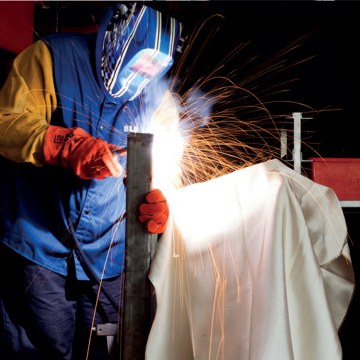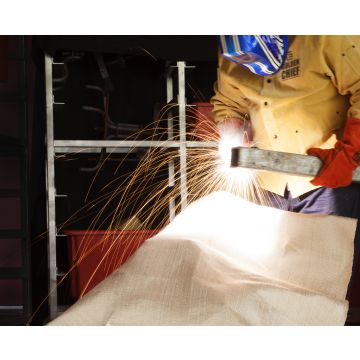The Difference between Welding Blankets and Drapes

Elliotts has a wide range of products designed to protect workers and their equipment from the hazards associated with welding/fabrication processes. With so many options to choose between — each of which have been manufactured from high-quality temperature-resistant fabrics — it is understandable to be overwhelmed by the options. Fortunately, the difference between welding blankets and drapes is quite simple.
Welding Blankets
Welding blankets are heat-resistant shields designed to cover an object during heat treatment.
Elliotts offers two fabrics for blankets: Heatshield and T1000. Both are manufactured from E Glass Fibre – a non-combustible, flexible material specifically designed to retain heat. Heatshield blankets can withstand a continuous working temperature of 500°C, while T1000 can withstand up to 800°C. Both come in either 900x1800mm/1800x1800mm sizes, although special sizes and roles are available on request.


Welding Drapes
Similar to welding blankets, welding drapes are also used as a shield. They are used to protect an immovable object in potential danger from nearby welding. To be truly effective, a drape should be carefully positioned so that the splatter and dross run off the fabric. Elliotts has three types of welding drapes: NeoWeld, SilicaGlass, and Leather.
NeoWeld is the most popular, being made of E-Glass fabric coated in flame-retardant neoprene that allows the weld splatter to slide off. It has a continuous working temperature of 260 °C, and comes in 900x1800/1700x1800mm sizes, or is custom-made by request.
Leather drapes are the most economical option and are carefully manufactured from selected chrome split leather. It comes in a wide variety of sizes — 900x1800mm/1800x1800mm/2000x2000mm/3000x3000mm — with even more options available by request. Leather drapes can withstand a continuous working temperature of up to 80°C.


SilicaGlass drapes are a premium option that can be used confidently over sensitive areas. It has a silica content of 96% and can withstand substantially higher temperatures than the alternatives, reaching a continuous working temperature of up to 1000°C. It comes in 300x300mm/900x1800mm/1700x1800mm or can be cut to custom specifications by request.
So what’s the difference?
The biggest difference between blankets and drapes is how they are used. Drapes are placed on top of objects to protect them from spatter just like a painter would cover furniture with a sheet or a tarp. Blankets are placed on top of objects which have been welded or heat treated to keep the heat in the object and bring the temperature down slowly. If they cool quickly in the open air the hot steel can crack and become weakened in the freshly welded joints.
CONTACT US
Elliotts has a wide array of welding protection, including drapes and blankets. If you are still unsure about which would suit your situation the best, feel free to get in contact with us. We would love to assist you! Call us on 07 3265 2944 or send us a message through our Contact page.







